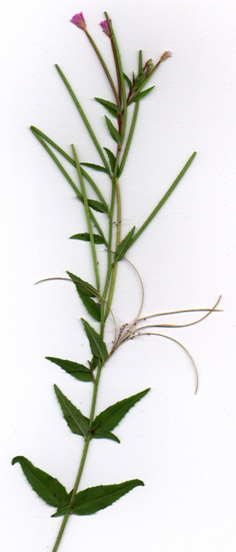
|
| Dwarf Fireweed; Epilobium ciliatum Rafin. |
Evening-Primrose Family; ONAGRACEÆ
|
| Compared to regular Fireweed (August 1988's weed of the month), Dwarf Fireweed is like a cheap throwaway ink pen
overshadowed by a fine fountain pen. This small version has none of the glamor, beauty and interest generated by the legion towering wands of
deep rosy flowers its famous cousin sports. "But," protests the dwarf, "my claim is ubiquity; unlike big Fireweed, I'm in
every garden." |
| Too true. Few weeds are as common. Dwarf Fireweed is one of our
natives. Nine out of ten weed species seen hereabouts
are from elsewhere: usually Europe. Dwarf Fireweed grew here thousands of years ago, and thrives from mountaintop to sea
level, wherever ample moisture allows. It owes its abundance to a supreme degree of adaptability and quickness to reseed. Therefore it is
in most Seattle yards, a despicable but not really harmful pest. |
| Dwarf Fireweed varies in size from several inches to six feet tall. The leaves are thin, borne in opposite pairs on the stems,
and are semiglossy when the plant is still very small. Beginning in May, the flowers are tiny pink to white affairs that give rise to
skinny seedpods, each of which ripens hundreds of fluffy seeds, liberated to the whims of the wind. In fall and winter, the plant can turn
an attractive reddish purple. |
| Shallow-rooted, it is easily controlled. But seedlings keep reappearing. On moist soil, especially of a clayey texture in
partial shade, the weed is commonest. It can flower and seed in its first year, but lives as a perennial. |
| Fireweed relatives include fuchsia and evening primrose. Every member of this family that I've eaten has been acrid,
with precious little distinctive flavor. Fireweed raw is not to my liking. If you have much of the weed, you might try cooking some. If
you can make it a dish to relish, you're a great chef indeed. |
Note: Dwarf Fireweed has been given several scientific names besides the one cited above. Others include
E. Watsonii, and E. adenocaulon.
|
Originally published as the Seattle Tilth newsletter Weed of the Month in November 1992, along with an illustration from a book.
Back |

